tow RENAULT MEGANE 2005 X84 / 2.G User Guide
[x] Cancel search | Manufacturer: RENAULT, Model Year: 2005, Model line: MEGANE, Model: RENAULT MEGANE 2005 X84 / 2.GPages: 250, PDF Size: 5.72 MB
Page 114 of 250

Downloaded from www.Manualslib.com manuals search engine
NU761_2_G2-FRA.qxd 4/11/05 10:48 Page 2.14
2.14
ENVIRONMENT
Your vehicle has been designed with
the aim of caring for the
environment.
Manufacture:
RENAULT has manufactured your
vehicle to comply with the strictest
environmental standards.
Furthermore, RENAULT has
implemented a system for checking
all of the vehicle components.
Emissions:
Your vehicle is equipped with an
emission control system including a
catalytic converter, an oxygen
sensor and an active carbon filter
(the latter prevents vapour from the
petrol tank being released into the
open air).
Recycling:
RENAULT has used all its expertise
to reduce environmental impact as
far as possible at the end of the
service life of your vehicle. This vehicle is more than 95%
recyclable. To make recycling easier,
many innovations have been
updated in the design of the vehicle
and the materials used.
The vehicle contains many parts
made of recycled plastics or
renewable materials (wood, cotton,
natural rubber etc.).
Make your contribution towards
protection of the environment too.
of routine vehicle maintenance
(vehicle battery, oil filter, air filter,
batteries etc.) and oil containers
(empty or filled with used oil)
must be disposed of through
specialist organisations.
life, it should be sent to approved
centres to ensure that it is
recycled.
legislation.
NU761_2_G2-ENG.qxp 03-Jan-06 20:48 Page 2.14 (Black/Process Black\
plate)
Page 125 of 250

Downloaded from www.Manualslib.com manuals search engine
1
2
5
3
4
6
NU761_2_G2-FRA.qxd 4/11/05 10:48 Page 2.25
CRUISE CONTROL/SPEED LIMITER: limiter function
The speed limiter function helps
you stay within the driving speed
limit that you choose.
This may be useful, for example, in
town driving or in areas with speed
restriction (roadworks), etc.
The system operates from a driving
speed of about 18 mph (30 km/h).Controls
1 On/Off switch.
2 Limit speed storage and increase
switch.
3 Recall of stored limit speed.
4 Switching the function off (with
limit speed storage).
5 Limit speed storage and decrease
switch.
Indicator light 6î
This orange indicator light on the
instrument panel lights up to
indicate that the limiter function is
in operation.
When the function is activated, the
message “Limiter” appears on the
instrument panel accompanied by
dashes.
2.25
NU761_2_G2-ENG.qxp 03-Jan-06 20:48 Page 2.25 (Black/Process Black\
plate)
Page 137 of 250
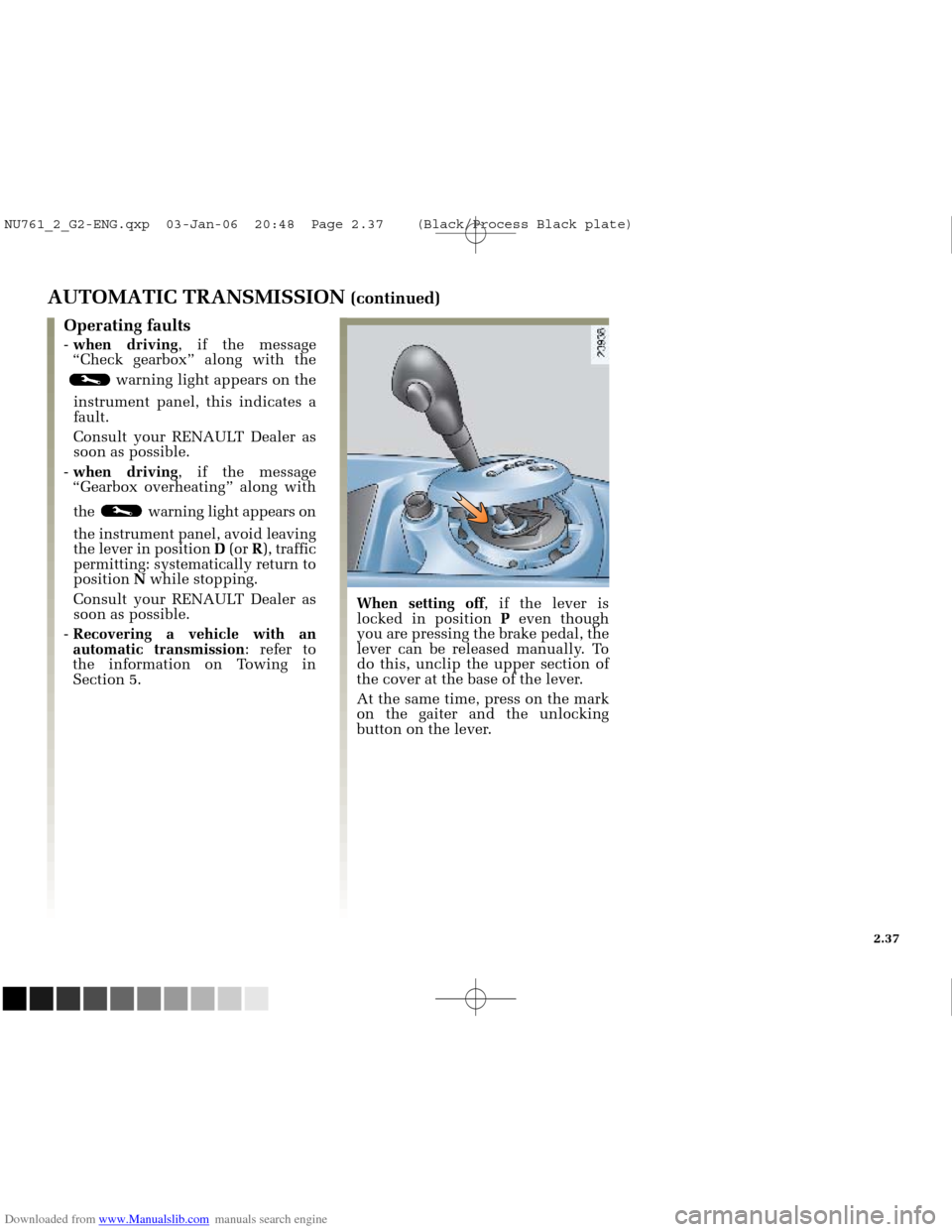
Downloaded from www.Manualslib.com manuals search engine
NU761_2_G2-FRA.qxd 4/11/05 10:49 Page 2.37
AUTOMATIC TRANSMISSION (continued)
Operating faults
- when driving , if the message
“Check gearbox” along with the
warning light appears on the
instrument panel, this indicates a
fault.
Consult your RENAULT Dealer as
soon as possible.
- when driving , if the message
“Gearbox overheating” along with
the warning light appears on
the instrument panel, avoid leaving
the lever in position D(or R), traffic
permitting: systematically return to
position Nwhile stopping.
Consult your RENAULT Dealer as
soon as possible.
- Recovering a vehicle with an
automatic transmission : refer to
the information on Towing in
Section 5.
When setting off , if the lever is
locked in position Peven though
you are pressing the brake pedal, the
lever can be released manually. To
do this, unclip the upper section of
the cover at the base of the lever.
At the same time, press on the mark
on the gaiter and the unlocking
button on the lever.
2.37
NU761_2_G2-ENG.qxp 03-Jan-06 20:48 Page 2.37 (Black/Process Black\
plate)
Page 143 of 250
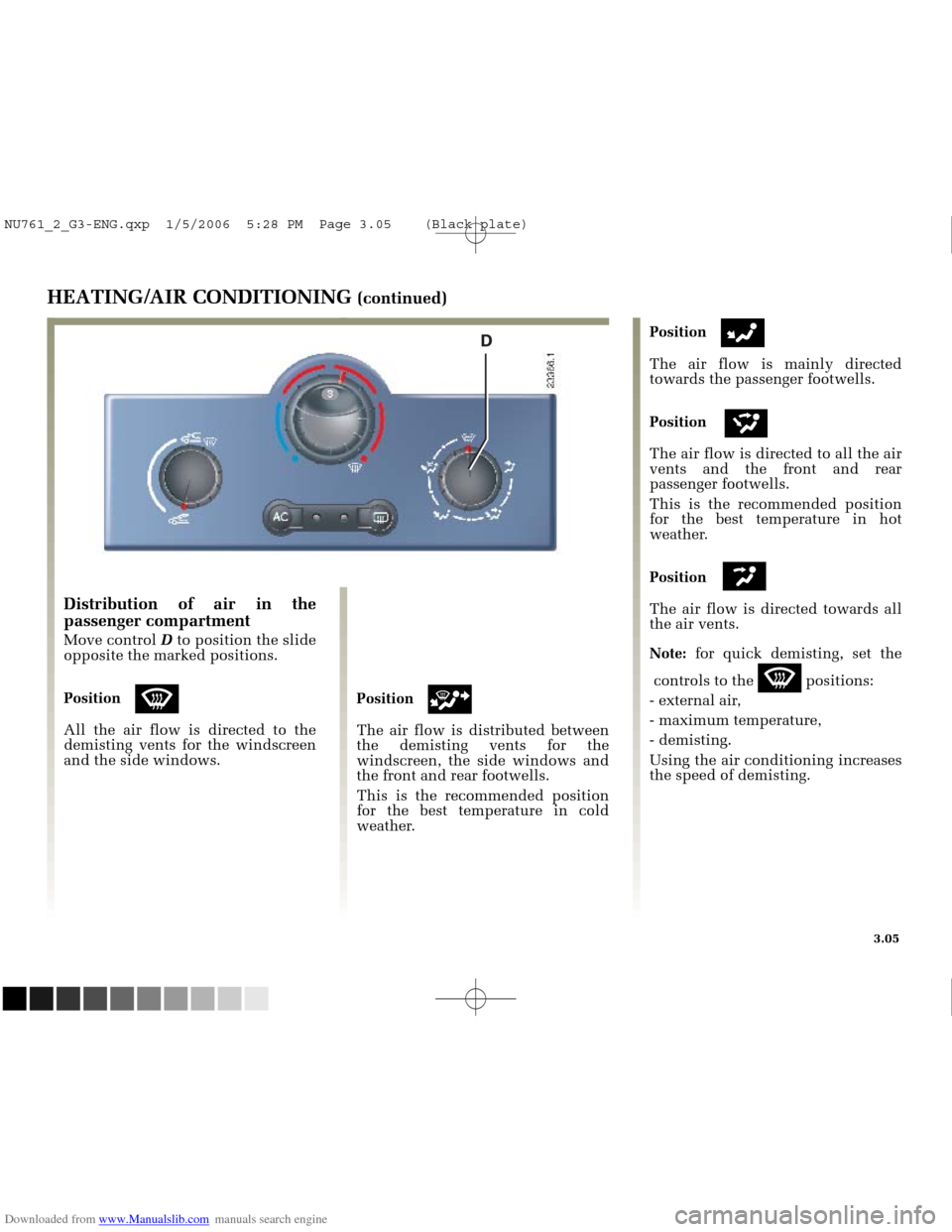
Downloaded from www.Manualslib.com manuals search engine
D
NU761_2_G3-FRA.qxd 4/11/05 10:51 Page 3.05
3.05
HEATING/AIR CONDITIONING (continued)
Distribution of air in the
passenger compartment
Move control Dto position the slide
opposite the marked positions.
Position
d
All the air flow is directed to the
demisting vents for the windscreen
and the side windows. Position
j
The air flow is distributed between
the demisting vents for the
windscreen, the side windows and
the front and rear footwells.
This is the recommended position
for the best temperature in cold
weather.Position
h
The air flow is mainly directed
towards the passenger footwells.
Position
The air flow is directed to all the air
vents and the front and rear
passenger footwells.
This is the recommended position
for the best temperature in hot
weather.
Position
The air flow is directed towards all
the air vents.
Note:
for quick demisting, set the
controls to the
dpositions:
- external air,
- maximum temperature,
- demisting.
Using the air conditioning increases
the speed of demisting.
NU761_2_G3-ENG.qxp 1/5/2006 5:28 PM Page 3.05 (Black plate)
Page 145 of 250
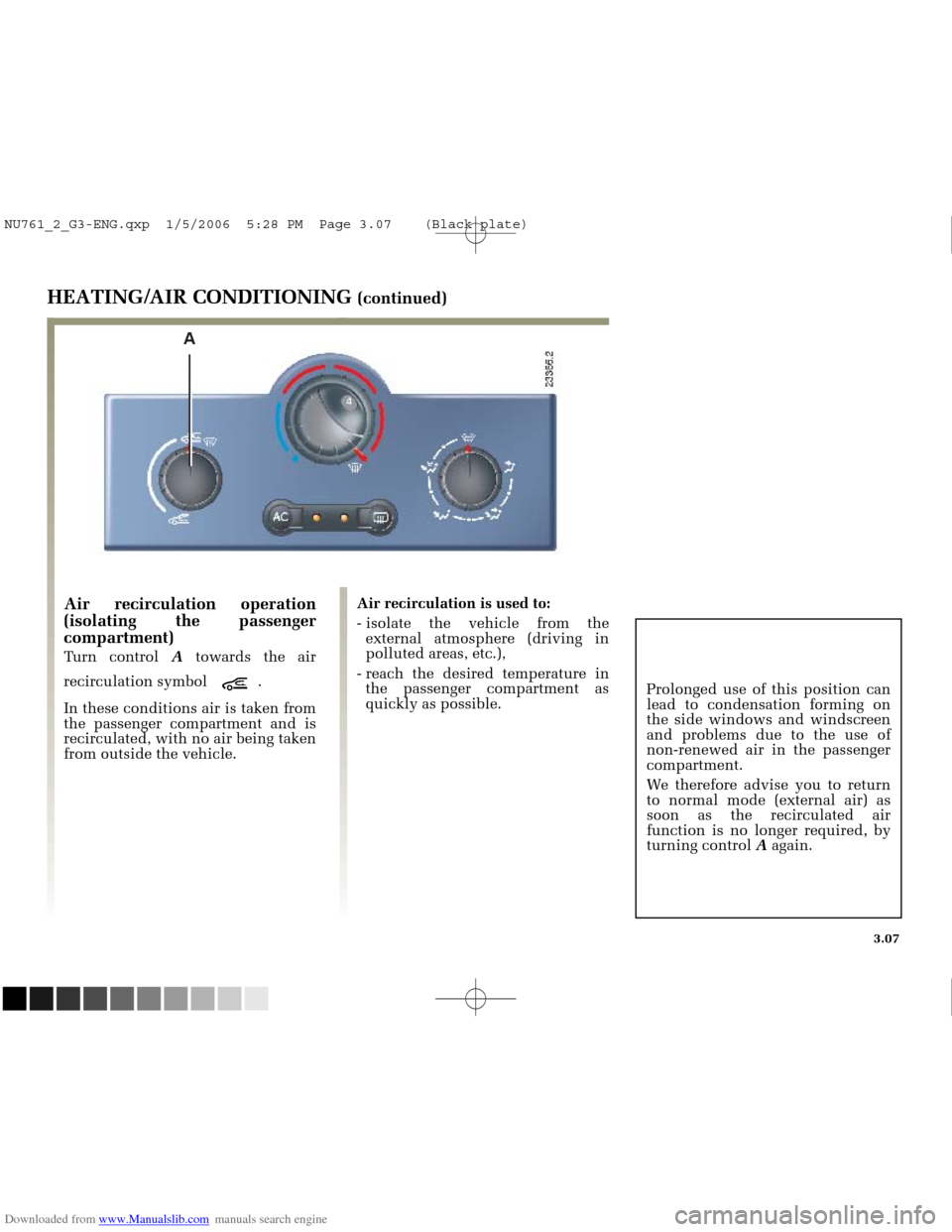
Downloaded from www.Manualslib.com manuals search engine
A
NU761_2_G3-FRA.qxd 4/11/05 10:51 Page 3.07
3.07
HEATING/AIR CONDITIONING (continued)
Air recirculation operation
(isolating the passenger
compartment)
Turn control Atowards the air
recirculation symbol .
In these conditions air is taken from
the passenger compartment and is
recirculated, with no air being taken
from outside the vehicle.
Air recirculation is used to:
- isolate the vehicle from the external atmosphere (driving in
polluted areas, etc.),
- reach the desired temperature in the passenger compartment as
quickly as possible. Prolonged use of this position can
lead to condensation forming on
the side windows and windscreen
and problems due to the use of
non-renewed air in the passenger
compartment.
We therefore advise you to return
to normal mode (external air) as
soon as the recirculated air
function is no longer required, by
turning control
Aagain.
NU761_2_G3-ENG.qxp 1/5/2006 5:28 PM Page 3.07 (Black plate)
Page 149 of 250

Downloaded from www.Manualslib.com manuals search engine
13 12 1110
568
NU761_2_G3-FRA.qxd 4/11/05 10:51 Page 3.11
3.11
CLIMATE CONTROL (continued)
Distribution of air in the
passenger compartment
There are 5 air distribution settings
available, which are obtained by
pressing buttons 8and 10. The
arrows on the display 5inform you
of the setting selected: Position
All the air flow is directed to the
demisting vents for the windscreen
and the side windows.
Position
The air flow is directed to the
windscreen demisting vents, the
side windows and the passenger
footwells.
Positionm
The air flow is directed towards all
the air vents.
Position
The air flow is directed to all the air
vents and the passenger footwells.
Position
The air flow is mainly directed
towards the passenger footwells.
The manual air distribution
option causes the operating
indicator on the display to
switch off
5(automatic mode),
but only air distribution is no
longer controlled automatically
by the system.
Press button 6to return to
automatic mode.
NU761_2_G3-ENG.qxp 1/5/2006 5:28 PM Page 3.11 (Black plate)
Page 154 of 250
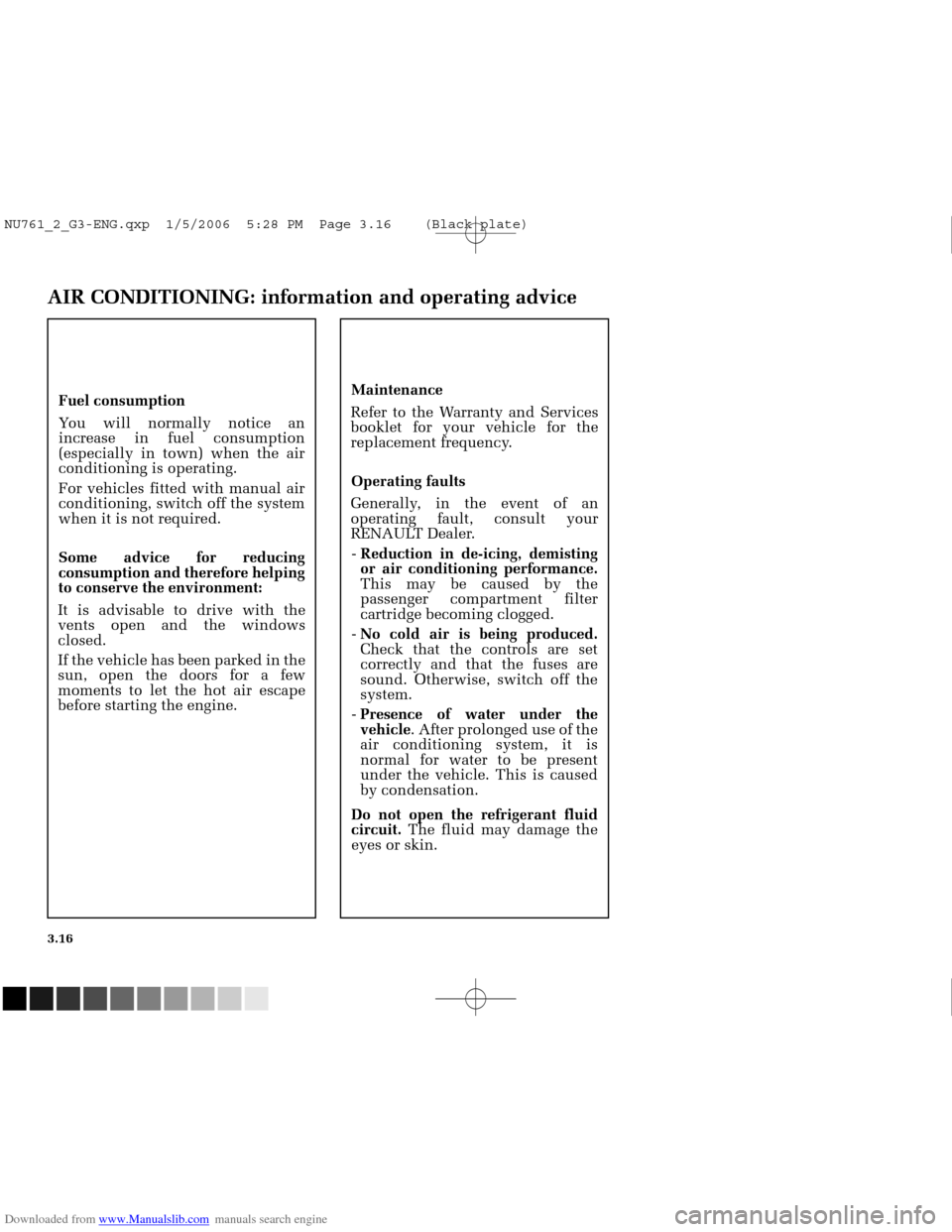
Downloaded from www.Manualslib.com manuals search engine
NU761_2_G3-FRA.qxd 4/11/05 10:51 Page 3.16
3.16
AIR CONDITIONING: information and operating advice
Fuel consumption
You will normally notice an
increase in fuel consumption
(especially in town) when the air
conditioning is operating.
For vehicles fitted with manual air
conditioning, switch off the system
when it is not required.
Some advice for reducing
consumption and therefore helping
to conserve the environment:
It is advisable to drive with the
vents open and the windows
closed.
If the vehicle has been parked in the
sun, open the doors for a few
moments to let the hot air escape
before starting the engine.Maintenance
Refer to the Warranty and Services
booklet for your vehicle for the
replacement frequency.
Operating faults
Generally, in the event of an
operating fault, consult your
RENAULT Dealer. - Reduction in de-icing, demisting
or air conditioning performance.
This may be caused by the
passenger compartment filter
cartridge becoming clogged.
- No cold air is being produced.
Check that the controls are set
correctly and that the fuses are
sound. Otherwise, switch off the
system.
- Presence of water under the
vehicle . After prolonged use of the
air conditioning system, it is
normal for water to be present
under the vehicle. This is caused
by condensation.
Do not open the refrigerant fluid
circuit. The fluid may damage the
eyes or skin.
NU761_2_G3-ENG.qxp 1/5/2006 5:28 PM Page 3.16 (Black plate)
Page 170 of 250
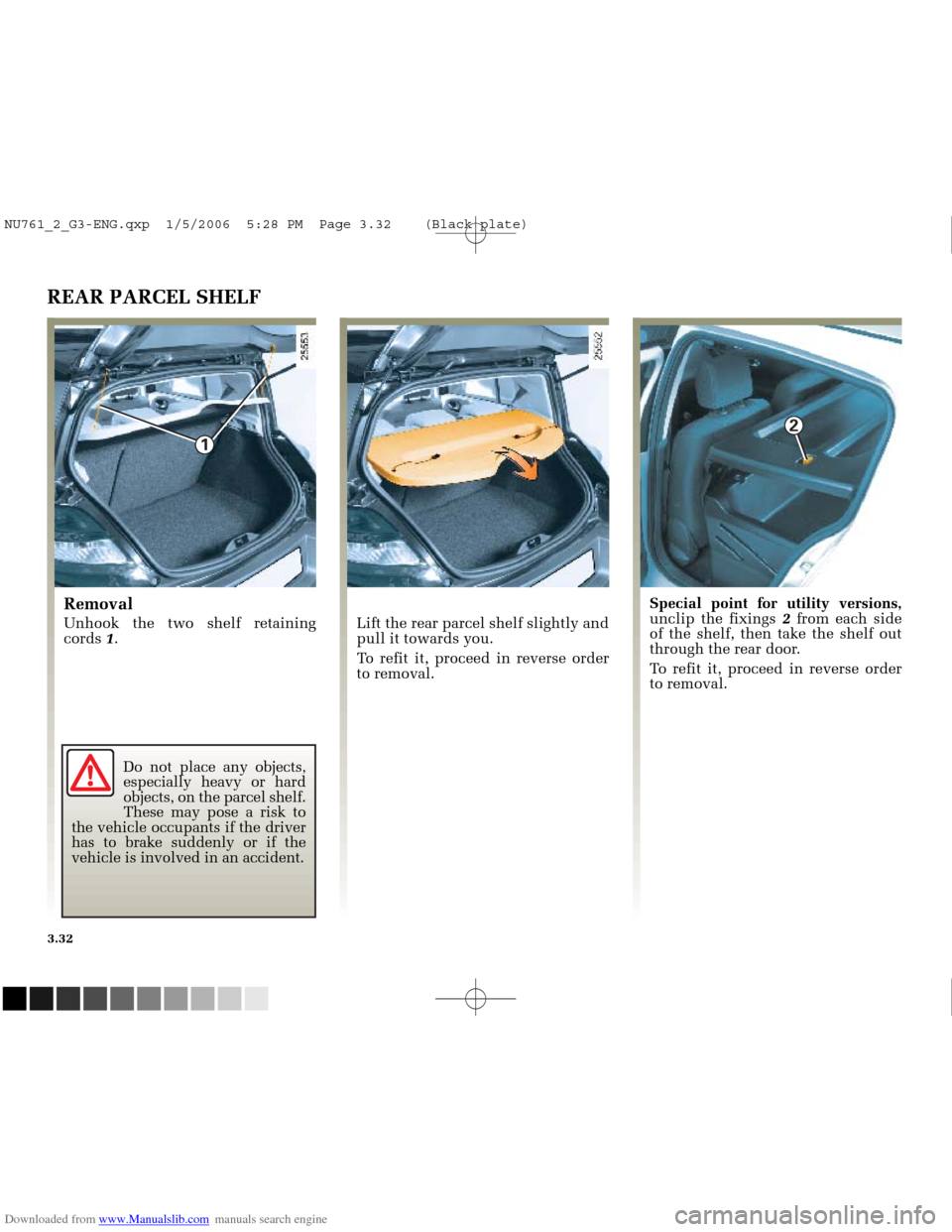
Downloaded from www.Manualslib.com manuals search engine
1
2
NU761_2_G3-FRA.qxd 4/11/05 10:52 Page 3.32
3.32
REAR PARCEL SHELF
Removal
Unhook the two shelf retaining
cords 1. Lift the rear parcel shelf slightly and
pull it towards you.
To refit it, proceed in reverse order
to removal. Special point for utility versions,
unclip the fixings
2from each side
of the shelf, then take the shelf out
through the rear door.
To refit it, proceed in reverse order
to removal.
Do not place any objects,
especially heavy or hard
objects, on the parcel shelf.
These may pose a risk to
the vehicle occupants if the driver
has to brake suddenly or if the
vehicle is involved in an accident.
NU761_2_G3-ENG.qxp 1/5/2006 5:28 PM Page 3.32 (Black plate)
Page 171 of 250

Downloaded from www.Manualslib.com manuals search engine
1
2
1
1
1
NU761_2_G3-FRA.qxd 4/11/05 10:52 Page 3.33
3.33
STORAGE COMPARTMENTS/LUGGAGE COMPARTMENT FITTINGS
Locations for anchorage points 1
These are useful for securing items
transported in the luggage
compartment (see the information
on transporting objects in the
luggage compartment).
Storage compartment inside the
emergency spare wheel area
To open, fold the carpet 2back
towards the rear bench seat (this
storage compartment can be used
to store tools, cloths, an oil
container, etc.).
NU761_2_G3-ENG.qxp 1/5/2006 5:28 PM Page 3.33 (Black plate)
Page 189 of 250
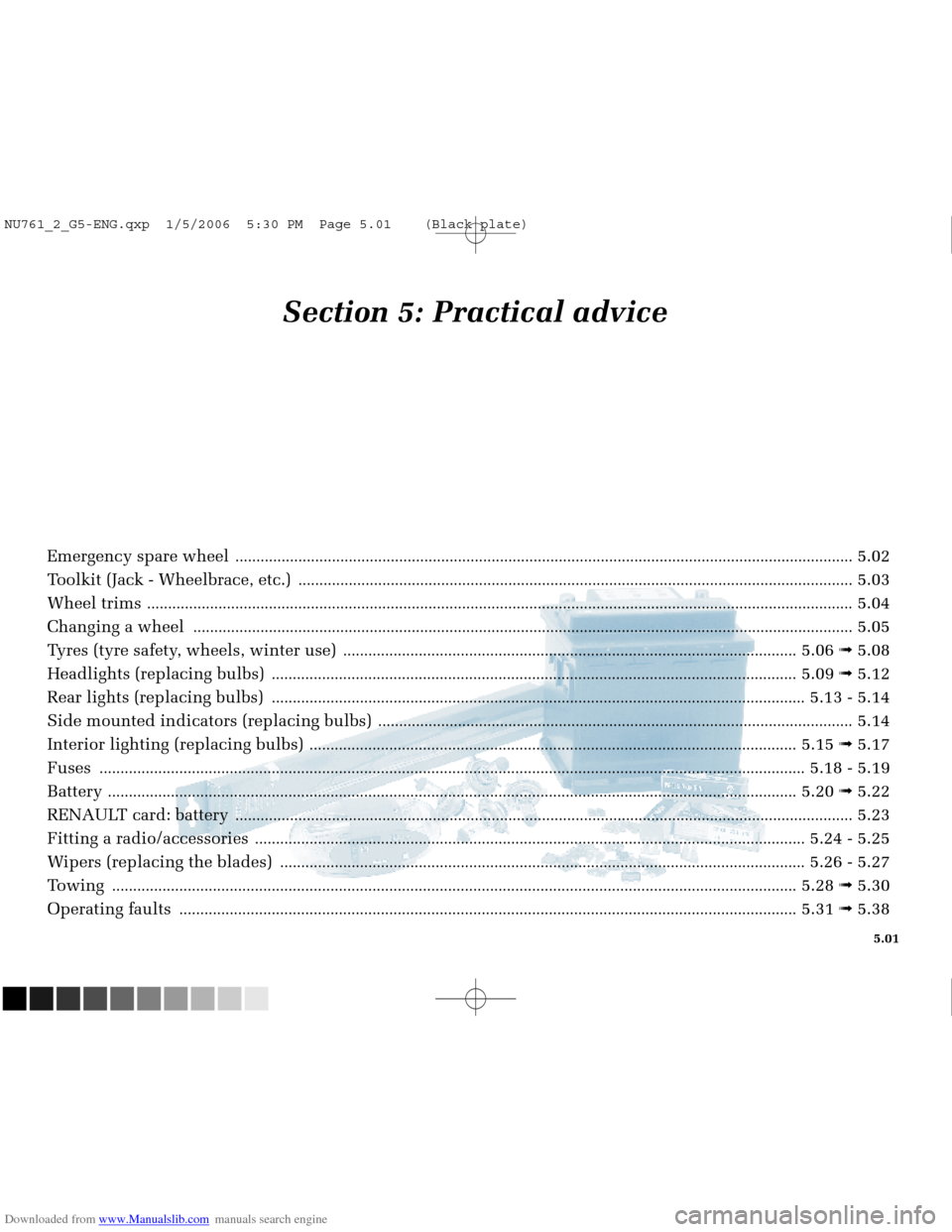
Downloaded from www.Manualslib.com manuals search engine
NU761_2_G5-FRA.qxd 4/11/05 11:09 Page 5.01
Section 5: Practical advice
Emergency spare wheel ........................................................................\
...........................................................................5.02
Toolkit (Jack - Wheelbrace, etc.)
........................................................................\
....................................................... .....5.03
Wheel trims
........................................................................\
....................................................... .........................................5.04
Changing a wheel
........................................................................\
....................................................... ..............................5.05
Tyres (tyre safety, wheels, winter use)
........................................................................\
....................................5.06 ➟5.08
Headlights (replacing bulbs)
........................................................................\
.....................................................5.09 ➟5.12
Rear lights (replacing bulbs)
........................................................................\
.......................................................5.13 - 5.14
Side mounted indicators (replacing bulbs)
........................................................................\
.........................................5.14
Interior lighting (replacing bulbs)
........................................................................\
............................................5.15 ➟5.17
Fuses
........................................................................\
....................................................... .........................................5.18 - 5.19
Battery
........................................................................\
....................................................... .....................................5.20 ➟5.22
RENAULT card: battery
........................................................................\
....................................................... ....................5.23
Fitting a radio/accessories
........................................................................\
....................................................... ....5.24 - 5.25
Wipers (replacing the blades)
........................................................................\
.....................................................5.26 - 5.27
Towing
........................................................................\
....................................................... ....................................5.28 ➟5.30
Operating faults
........................................................................\
....................................................... ....................5.31 ➟5.38
5.01
NU761_2_G5-ENG.qxp 1/5/2006 5:30 PM Page 5.01 (Black plate)